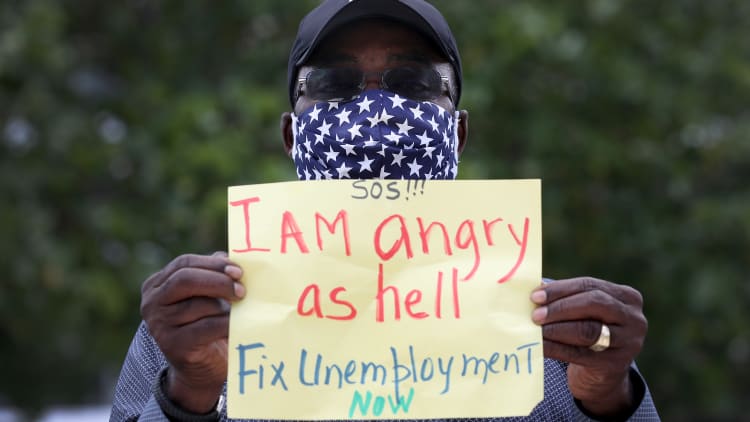President Donald Trump signed a series of executive orders Saturday in an effort to bypass congressional negotiations and extend financial relief to tens of millions of Americans during the coronavirus pandemic. One order would extend enhanced unemployment benefits at a reduced rate of $400 per week.
The federal benefit is intended to replace the previous provision that gave out-of-work Americans an extra $600 per week in benefits, on top of state-administered pay, which expired July 31.
Under the new order, the federal government would cover $300 in enhanced aid per person per week, and states would be responsible for the remaining $100.
Lawmakers, economists and unemployment experts have responded to the memorandum saying the new "lost wages assistance" program would be difficult to implement in a timely manner, and that it excludes some of the lowest-paid workers in need of jobless aid. The order could also face a legal challenge over whether the president has the authority to enact the program.
Here's how boosted unemployment would work under the new order.
Who would qualify for the $400 weekly boost?
Under the March CARES Act, anyone receiving unemployment benefits was eligible to get the $600 weekly boost.
In the new order, however, recipients must be receiving at least $100 in unemployment aid in order to qualify for the extra $400 federal boost. This could leave out the lowest earners, particularly those who rely on tips or part-time work.
Eliza Forsythe, labor economist and assistant professor at University of Illinois, Urbana-Champaign, estimates about 6% of regular unemployment recipients earn less than $100 in state benefits.
Furthermore, states set their own minimum unemployment benefit to workers with low earnings histories. In Hawaii, the minimum unemployment benefit is just $5 per week; the average state benefit was $456.19 in June, according to Department of Labor data.
The White House said the $100-a-week minimum to qualify for enhanced benefits is an effort to curb fraud. The FBI has reported an increase in unemployment insurance fraud in recent months, though activity has been linked to identity theft rather than recipients inflating their earnings history to boost benefits.
Under the CARES Act, people without required documentation of their earning history, including freelancers, the self-employed and gig workers, were newly eligible for benefits at a minimum of half the average unemployment benefit in their state. It's likely many of these Pandemic Unemployment Assistance recipients will meet the new $100 benefit threshold to get the extra $400 boost.
People receiving 13 weeks of extended aid under Pandemic Unemployment Emergency Compensation would also qualify for the federal boost, so long as they're collecting at least $100 in regular state aid.
When will the $400 weekly benefit start?
According to the memorandum, new federal aid will apply retroactively to people receiving unemployment benefits for the week ending August 1, 2020, effectively bridging the gap since the $600 provision expired at the end of July.
Treasury Secretary Steven Mnuchin said jobless benefits could be available "immediately," The Washington Post reports. White House economic adviser Larry Kudlow said on CNN that payments could take a couple of weeks.
Unemployment experts have already warned that, due to outdated state systems, extension of any kind of aid could take weeks to implement. Even extending the $600 weekly aid as-is could take two to four weeks to reprogram, says Michele Evermore, senior policy analyst at the National Employment Law Project.
How long will the new benefit last?
Federal aid would be funded with $44 billion from the Department of Homeland Security's disaster relief fund. Governors would work with the Federal Emergency Management Administration (FEMA), which traditionally handles relief for events such as hurricanes and wildfires, to manage the new initiative.
According to the order, the program would run until December 6, until the $44 billion FEMA aid runs out, or until Congress passes new legislation regarding federal unemployment benefits — whichever event occurs first.
Analysts with the Committee for a Responsible Federal Budget estimate the $44 billion in FEMA resources would last roughly five weeks, until August 29, 2020.
Beyond federal funding, states already facing budget shortfalls would be responsible in covering the remaining 25% of the benefit. The Trump order notes states can draw from $110 billion in existing relief funds under the CARES Act, though many are quickly depleting these resources. According to the Center on Budget and Policy Priorities, some states have already allocated all of their coronavirus relief funding (including California, Colorado, and Mississippi) or large parts of it (including Iowa, Kentucky, Louisiana, New Hampshire, North Dakota and South Carolina).
The latest report from the Treasury Inspector General says $80 billion of this relief aid remains available.
What happens next?
It's unclear whether the president has the authority to take any of these actions, because Congress controls federal spending. His orders will likely be challenged in court.
The orders could also become null if Congress acts to pass new legislation about the next round of pandemic relief. Negotiations between Democrats, Republicans and the White House have been fraught in recent weeks. House Democrats wish to extend the $600 federal benefit into 2021, while Senate Republicans proposed to offer a reduced $200 per week through September and a 70% wage replacement through the end of the year.
House Speaker Nancy Pelosi, D-Calif., and Senate Minority Leader Chuck Schumer, D-NY, have met with Treasury Secretary Mnuchin and White House chief of staff Mark Meadows in recent days. The four officials emerged from a three-hour meeting Thursday night without a deal.

Pelosi and Schumer responded to the Trump orders this weekend expressing disappointment in the "unworkable, weak and narrow policy announcements to slash the unemployment benefits that millions desperately need."
Treasury Secretary Mnuchin told CNBC Monday that the White House is open to continuing coronavirus aid talks with Democrats, though he didn't give a timeline of when these discussions resume.
"Again, if we can get a fair deal we're willing to do it this week," Mnuchin said.
CNBC Make It is NOW STREAMING on Peacock. Find our original programming in the Channels section.
Don't miss:
Will enhanced unemployment benefits be extended by Congress? Here's what to know
Nearly half of all furloughed workers now believe their temporary layoff will become permanent



